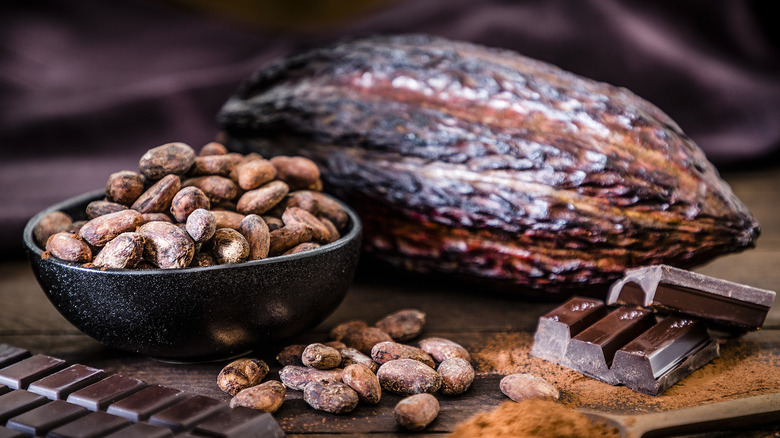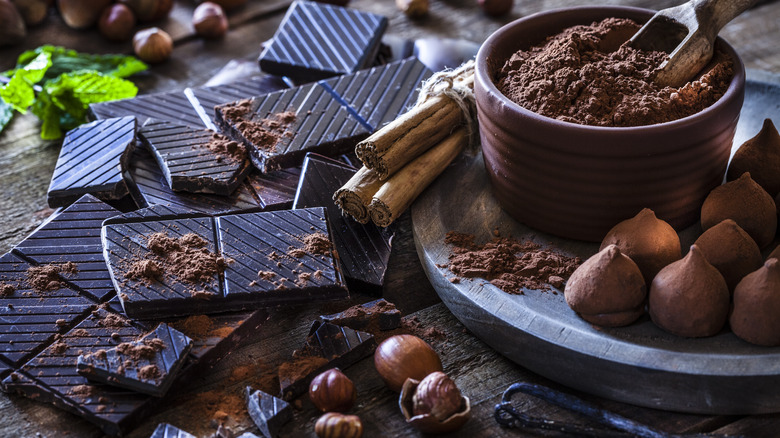Here's What The Cocoa Percentage Of Chocolate Really Means
Any chocophile has no doubt noticed that chocolate bars can have different cocoa percentages that range anywhere from the low 20s or 30s to 100%. These percentages can tell you a lot about the flavor profile and intensity you can expect from your chosen chocolate. To understand what these percentages mean, it helps to have a thorough grasp of how chocolate is made in the first place.
Chocolate comes from cacao beans harvested from the cacao tree. There is some debate on the difference between "cacao" and "cocoa," but cacao generally refers to the raw form of the beans, while cocoa is used to describe the beans once they have been processed. After being fermented, dried, and roasted, cacao nibs are separated from the bean's casing. These raw cacao nibs are composed of solid cocoa and cocoa butter or fat. The nibs are run through a grinding machine, and as they are ground, they turn into cocoa liquor (which is not alcoholic). As the nibs are ground, other ingredients like sugar and vanilla are added to the mixture before the final chocolate product is tempered and packaged. The ratio of pure cocoa products to other ingredients is denoted by the cocoa percentage.
The cocoa percentage is the amount of actual cocoa in the chocolate
For example, if a chocolate bar has a cocoa percentage of 75%, that means that 75% of the recipe comes directly from the cacao bean. This "cocoa mass," as it's sometimes referred to, includes the cocoa butter and the cocoa liquor that forms during the grinding process. The other 25% of the recipe is anything that isn't chocolate. Typically, this is mostly sugar, but depending on the chocolate, it can also be powdered milk or a bit of vanilla.
Different cocoa percentages are required for certain types of chocolate, like milk or dark chocolate, to earn their label. If you're in the mood for dark chocolate, you'll usually be looking for a bar with a minimum cocoa percentage of 60%. These requirements also vary depending on what country the chocolate is made in. The U.K., for instance, requires that milk chocolate have a cocoa percentage of at least 25%. In comparison, only 10% is needed in the U.S. That's why a lot of American chocolate, like Hershey's bars (which have a cocoa percentage of 11%), is often thought of as "not real chocolate" by cocoa connoisseurs.
What to expect with a higher cocoa percentage
Dark chocolate with a high cocoa content can actually have a few health benefits. Generally speaking, the higher a chocolate's cocoa content, the less room there is for sugar. This can differ from brand to brand, so be sure to check the nutritional information of specific bars to ensure the sugar content is true to the label. Dark chocolate also has a fair bit of nutrients. According to Healthline, it is a good source of antioxidants as well as iron, fiber, and minerals like magnesium and copper.
At the end of the day, the importance of the cocoa percentage is up to you. If you want to try indulging in a higher percentage of chocolate, prepare for a different experience than the candy bar chocolate you may be used to. Because it doesn't have a sugar content as high as milk chocolate, dark chocolate can be rather bitter, especially if you surpass 80% cocoa percentage. It can be an acquired taste, but once you learn to appreciate the roasted velvety flavor and the unique floral, vanilla, or even spicy notes of individual bars, you may never return to super sweet confectionary chocolate.


